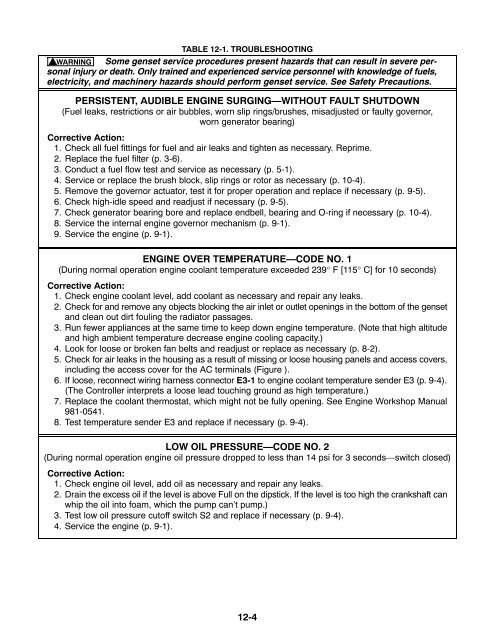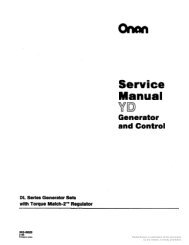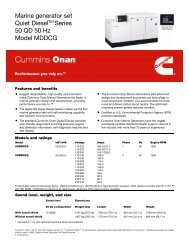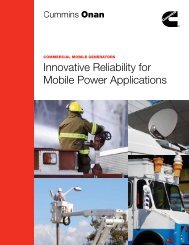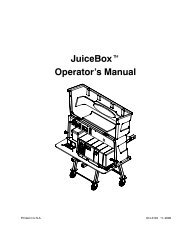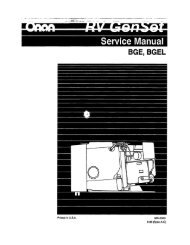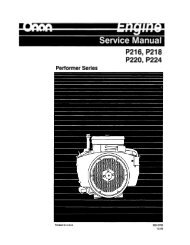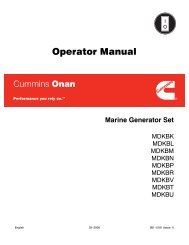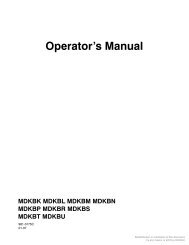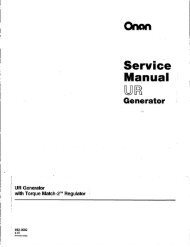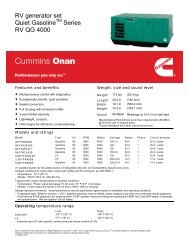Caution: This document contains mixed page sizes ... - Cummins Onan
Caution: This document contains mixed page sizes ... - Cummins Onan
Caution: This document contains mixed page sizes ... - Cummins Onan
Create successful ePaper yourself
Turn your PDF publications into a flip-book with our unique Google optimized e-Paper software.
TABLE 12-1. TROUBLESHOOTING<br />
WARNING Some genset service procedures present hazards that can result in severe personal<br />
injury or death. Only trained and experienced service personnel with knowledge of fuels,<br />
electricity, and machinery hazards should perform genset service. See Safety Precautions.<br />
PERSISTENT, AUDIBLE ENGINE SURGING—WITHOUT FAULT SHUTDOWN<br />
(Fuel leaks, restrictions or air bubbles, worn slip rings/brushes, misadjusted or faulty governor,<br />
worn generator bearing)<br />
Corrective Action:<br />
1. Check all fuel fittings for fuel and air leaks and tighten as necessary. Reprime.<br />
2. Replace the fuel filter (p. 3-6).<br />
3. Conduct a fuel flow test and service as necessary (p. 5-1).<br />
4. Service or replace the brush block, slip rings or rotor as necessary (p. 10-4).<br />
5. Remove the governor actuator, test it for proper operation and replace if necessary (p. 9-5).<br />
6. Check high-idle speed and readjust if necessary (p. 9-5).<br />
7. Check generator bearing bore and replace endbell, bearing and O-ring if necessary (p. 10-4).<br />
8. Service the internal engine governor mechanism (p. 9-1).<br />
9. Service the engine (p. 9-1).<br />
ENGINE OVER TEMPERATURE—CODE NO. 1<br />
(During normal operation engine coolant temperature exceeded 239° F [115° C] for 10 seconds)<br />
Corrective Action:<br />
1. Check engine coolant level, add coolant as necessary and repair any leaks.<br />
2. Check for and remove any objects blocking the air inlet or outlet openings in the bottom of the genset<br />
and clean out dirt fouling the radiator passages.<br />
3. Run fewer appliances at the same time to keep down engine temperature. (Note that high altitude<br />
and high ambient temperature decrease engine cooling capacity.)<br />
4. Look for loose or broken fan belts and readjust or replace as necessary (p. 8-2).<br />
5. Check for air leaks in the housing as a result of missing or loose housing panels and access covers,<br />
including the access cover for the AC terminals (Figure ).<br />
6. If loose, reconnect wiring harness connector E3-1 to engine coolant temperature sender E3 (p. 9-4).<br />
(The Controller interprets a loose lead touching ground as high temperature.)<br />
7. Replace the coolant thermostat, which might not be fully opening. See Engine Workshop Manual<br />
981-0541.<br />
8. Test temperature sender E3 and replace if necessary (p. 9-4).<br />
LOW OIL PRESSURE—CODE NO. 2<br />
(During normal operation engine oil pressure dropped to less than 14 psi for 3 seconds—switch closed)<br />
Corrective Action:<br />
1. Check engine oil level, add oil as necessary and repair any leaks.<br />
2. Drain the excess oil if the level is above Full on the dipstick. If the level is too high the crankshaft can<br />
whip the oil into foam, which the pump can’t pump.)<br />
3. Test low oil pressure cutoff switch S2 and replace if necessary (p. 9-4).<br />
4. Service the engine (p. 9-1).<br />
12-4


